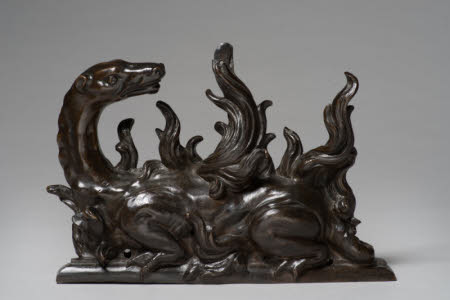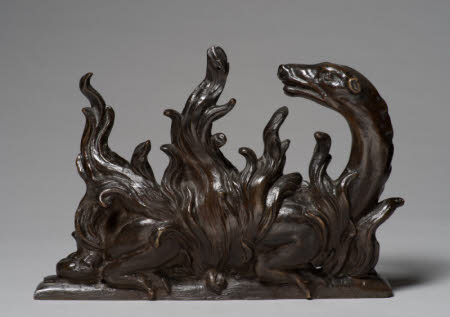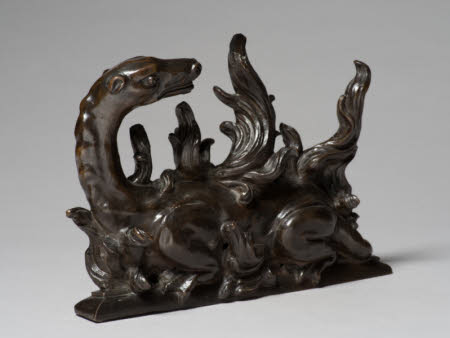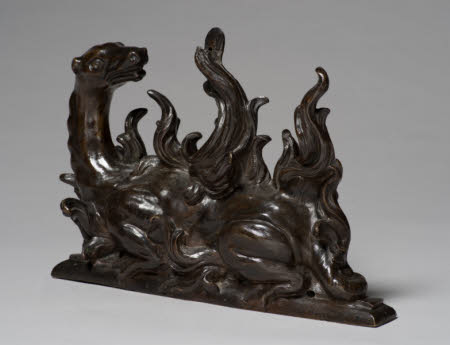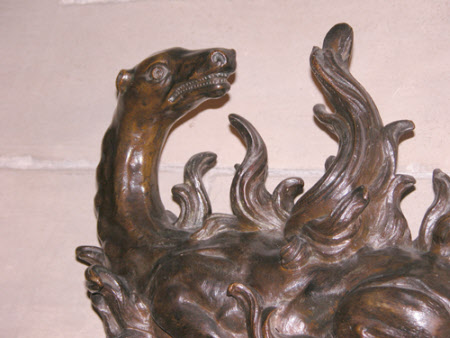Salamander
French School
Category
Art / Sculpture
Date
c. 1700 - 1830
Materials
Bronze
Measurements
256 x 355 x 50 mm
Place of origin
France
Order this imageCollection
Anglesey Abbey, Cambridgeshire
NT 514939
Summary
A bronze depiction of a salamander among flames, it's head rearing up at left. The salamander was the personal emblem of King Francis I of France (1494-1547, reigned 1515-47). Flames rise from a single point behind the salamander, which is made to be seen from both sides. Three holes for fixing the bronze, two at bottom left and right, the third in the uppermost flame, which is partly broken. The surface is quite extensively worked, with gentle hammering.
Full description
The plaque shows a salamander, a newt-like amphibian, the best-known salamander species of which in Europe is the fire salamander (Salamandra salamandra), with a black skin with conspicuous yellow spots and stripes. From a very early date the salamander was credited with the ability, for example by the Greek and Roman writers Aristotle and Pliny, to withstand and even extinguish fire. The notion was revived in medieval bestiaries and in the Renaissance, as an allegorical symbol of love. Leonardo da Vinci suggested that the salamander deliberately entered fires, in order to renew its skin. The salamander was adopted as his emblem by King Francis I of France, an almost exact contemporary of King Henry VIII of England and one of Henry’s principal rivals on the European stage. It became a ubiquitous emblem for the king, used everywhere in his various residences (Anne-Marie Lecoq, François Ier imaginaire. Symbolique et politique à l’aube de la Renaissance française, Paris 1987, esp. pp. 35-52, ‘Le prince à la salamandre’; Mino Gabriele, ‘La tempérante salamandre. Aux origines de la devise de François Ier’, in Bruno Petey-Girard and Magali Vène, eds., François Ier. Pouvoir et Image, exh. cat., Bibliothèque Nationale de France, Paris 2015, pp. 78-87). The first use by Francis of the salamander device is found in an anonymous medal dated 1504, when Francis, then just ten years old, was titled duc de Valois (G.F. Hill, A Corpus of Italian Medals of the Renaissance before Cellini, 2 vols., London 1930, no. 848; examples in the Victoria and Albert Museum, A.224-1910, and the Wallace Collection, S339). The medal also features a version of the related motto adopted by Francis, Notrisco al buono stingo el reo (‘I feed myself from the good fire and extinguish what is bad’), which is intended to suggest that Francis had the power to overcome and conquer enemies and difficulties, in just the same way that the salamander enjoyed the ability to renew itself from the flames. In the spirit of the motto, some of the salamanders made during the reign of Francis may be seen consuming fire or spitting out water through their mouths. The salamander thus became indissolubly linked with the French king, an element in the image he sought to propagate to the world. As a result, there are innumerable examples of its use during Francis’s reign, in buildings, medals, books and manuscripts, paintings and furniture. These include oak panels in the Victoria & Albert Museum depicting the salamander, in one of which (Inv. 863-1895) the animal is seen crouching, crowned and surrounded by flames and in another pair of panels (Inv. 786-1895) is paired with a dolphin representing the dauphin, the title of the heir to the French crown. Although it would be logical to assume that the bronze rendition of the salamander at Anglesey Abbey was also made during Francis I’s lifetime, in these contemporary depictions the animal is generally (if not always) shown crowned and belching flames, which is not the case here. In addition, the facture of the bronze sculpture would in fact rather suggest a later date, in the seventeenth or the eighteenth century, or even the early nineteenth century, when it became more common to depict the salamander without the crown. Indeed, when he sold it to Lord Fairhaven in August 1938, the bronze was described by the dealer Bensimon as dating from c. 1760, which may not be far from the truth. There was great interest in the earlier history of France in the decades before the French Revolution and, in 1769, the historian Gabriel-Henri Gaillard published a major study of the life of the king in 8 volumes, the Histoire de François Ier. Publications such as Gaillard’s could well have provided the impetus for the making of new versions of the salamander device, whilst after the reinstatement of the monarchy after the defeat of Napoleon in 1815 led to a surge of interest in earlier French monarchs, especially romantic figures such as Francis I. Jeremy Warren 2019
Provenance
Purchased by Urban Huttleston Rogers Broughton, 1st Lord Fairhaven (1896-1966) from Bensimon, Paris, on 20 August 1938 for £10; bequeathed to the National Trust by Lord Fairhaven (1896-1966) with the house and the rest of the contents.
Credit line
Anglesey Abbey, The Fairhaven Collection (The National Trust)
Makers and roles
French School, sculptor
References
Christie, Manson & Woods 1971: The National Trust, Anglesey Abbey, Cambridge. Inventory: Furniture, Textiles, Porcelain, Bronzes, Sculpture and Garden Ornaments’, 1971, p. 145.
